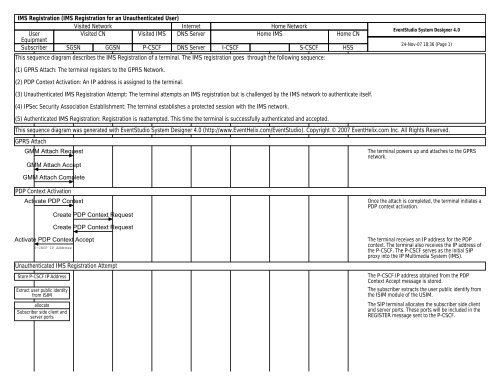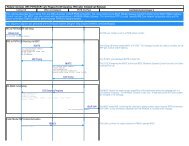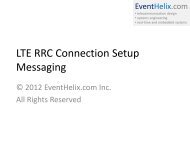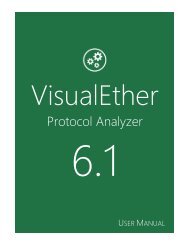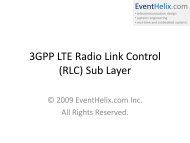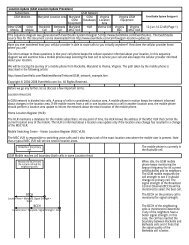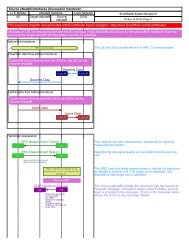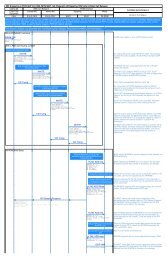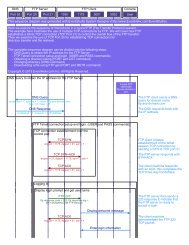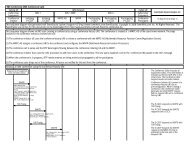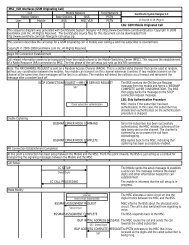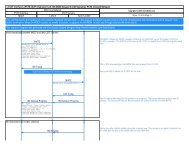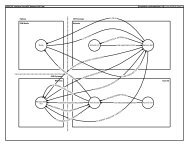IMS Registration for an Unauthenticated User - EventHelix.com
IMS Registration for an Unauthenticated User - EventHelix.com
IMS Registration for an Unauthenticated User - EventHelix.com
Create successful ePaper yourself
Turn your PDF publications into a flip-book with our unique Google optimized e-Paper software.
<strong>IMS</strong> <strong>Registration</strong> (<strong>IMS</strong> <strong>Registration</strong> <strong>for</strong> <strong>an</strong> <strong>Unauthenticated</strong> <strong>User</strong>)<br />
Visited Network Internet Home Network<br />
<strong>User</strong><br />
Visited CN Visited <strong>IMS</strong> DNS Server Home <strong>IMS</strong> Home CN<br />
Equipment<br />
Subscriber SGSN GGSN P-CSCF DNS Server I-CSCF S-CSCF HSS<br />
This sequence diagram describes the <strong>IMS</strong> <strong>Registration</strong> of a terminal. The <strong>IMS</strong> registration goes through the following sequence:<br />
EventStudio System Designer 4.0<br />
24-Nov-07 18:36 (Page 1)<br />
(1) GPRS Attach: The terminal registers to the GPRS Network.<br />
(2) PDP Context Activation: An IP address is assigned to the terminal.<br />
(3) <strong>Unauthenticated</strong> <strong>IMS</strong> <strong>Registration</strong> Attempt: The terminal attempts <strong>an</strong> <strong>IMS</strong> registration but is challenged by the <strong>IMS</strong> network to authenticate itself.<br />
(4) IPSec Security Association Establishment: The terminal establishes a protected session with the <strong>IMS</strong> network.<br />
(5) Authenticated <strong>IMS</strong> <strong>Registration</strong>: <strong>Registration</strong> is reattempted. This time the terminal is successfully authenticated <strong>an</strong>d accepted.<br />
This sequence diagram was generated with EventStudio System Designer 4.0 (http://www.<strong>EventHelix</strong>.<strong>com</strong>/EventStudio). Copyright © 2007 <strong>EventHelix</strong>.<strong>com</strong> Inc. All Rights Reserved.<br />
GPRS Attach<br />
GMM Attach Request<br />
GMM Attach Accept<br />
The terminal powers up <strong>an</strong>d attaches to the GPRS<br />
network.<br />
GMM Attach Complete<br />
PDP Context Activation<br />
Activate PDP Context<br />
Create PDP Context Request<br />
Once the attach is <strong>com</strong>pleted, the terminal initiates a<br />
PDP context activation.<br />
Create PDP Context Request<br />
Activate PDP Context Accept<br />
P-CSCF IP Address<br />
<strong>Unauthenticated</strong> <strong>IMS</strong> <strong>Registration</strong> Attempt<br />
Store P-CSCF IP Address<br />
Extract user public identity<br />
from ISIM<br />
allocate<br />
Subscriber side client <strong>an</strong>d<br />
server ports<br />
The terminal receives <strong>an</strong> IP address <strong>for</strong> the PDP<br />
context. The terminal also receives the IP address of<br />
the P-CSCF. The P-CSCF serves as the initial SIP<br />
proxy into the IP Multimedia System (<strong>IMS</strong>).<br />
The P-CSCF IP address obtained from the PDP<br />
Context Accept message is stored.<br />
The subscriber extracts the user public identify from<br />
the ISIM module of the USIM.<br />
The SIP terminal allocates the subscriber side client<br />
<strong>an</strong>d server ports. These ports will be included in the<br />
REGISTER message sent to the P-CSCF.
<strong>IMS</strong> <strong>Registration</strong> (<strong>IMS</strong> <strong>Registration</strong> <strong>for</strong> <strong>an</strong> <strong>Unauthenticated</strong> <strong>User</strong>)<br />
Visited Network Internet Home Network<br />
<strong>User</strong><br />
Visited CN Visited <strong>IMS</strong> DNS Server Home <strong>IMS</strong> Home CN<br />
Equipment<br />
Subscriber SGSN GGSN P-CSCF DNS Server I-CSCF S-CSCF HSS<br />
REGISTER<br />
REGISTER sip:hims.net SIP/2.0,<br />
Via: SIP/2.0/UDP UE-IP;br<strong>an</strong>ch=0abab,<br />
Route: sip:[P-CSCF-IP],<br />
Max-Forwards: 20,<br />
From: ;tag=abbb,<br />
To: ,<br />
Contact: ;expires=90000,<br />
Call-ID: ababab,<br />
CSeq: 25 REGISTER,<br />
Security-Client: port-s, port-c,<br />
Authorization: Digest username = name.private@hims.net,<br />
Content-Length: 0<br />
DNS Query<br />
domain = hims.net<br />
DNS Response<br />
ip = ICSCF-IP<br />
REGISTER<br />
REGISTER sip:hims.net SIP/2.0,<br />
Via: SIP/2.0/UDP<br />
pcscf1.vims.net;br<strong>an</strong>ch=0aab1,<br />
Via: SIP/2.0/UDP UE-IP;br<strong>an</strong>ch=0abab,<br />
Max-Forwards: 19,<br />
From: ;tag=abbb,<br />
To: ,<br />
Contact: ;expires=90000,<br />
Call-ID: ababab,<br />
CSeq: 25 REGISTER,<br />
Content-Length: 0,<br />
Authorization: Digest username =<br />
name.private@hims.net integrity protection:<br />
no<br />
<strong>User</strong> Authorization Request<br />
name.private@hims.net<br />
S-CSCF Name,<br />
S-CSCF Capabilities<br />
Select S-CSCF<br />
<strong>User</strong> Authorization Answer<br />
REGISTER<br />
REGISTER sip:hims.net SIP/2.0,<br />
Via: SIP/2.0/UDP<br />
icscf1.hims.net;br<strong>an</strong>ch=0aab2,<br />
Via: SIP/2.0/UDP<br />
pcscf1.vims.net;br<strong>an</strong>ch=0aab1,<br />
Via: SIP/2.0/UDP UE-IP;br<strong>an</strong>ch=0abab,<br />
Route: sip:scscf1.hims.net,<br />
Max-Forwards: 18,<br />
From: ;tag=abbb,<br />
To: ,<br />
Contact: ;expires=90000,<br />
Call-ID: ababab,<br />
CSeq: 25 REGISTER,<br />
Content-Length: 0,<br />
Authorization: Digest username =<br />
name.private@hims.net integrity protection:<br />
no<br />
EventStudio System Designer 4.0<br />
24-Nov-07 18:36 (Page 2)<br />
The subscriber sends a Register message to in<strong>for</strong>m<br />
the network that the specified user public identify<br />
(myname@mynetwork.<strong>com</strong>) is available at the IP<br />
address indicated in the Contact Header. The <strong>User</strong><br />
Equipment (UE) also adds a via header to record that<br />
the message had traversed the UE. The REGISTER<br />
message also includes the server <strong>an</strong>d client ports.<br />
Note that the message itself is sent on the st<strong>an</strong>dard<br />
SIP port 5060.<br />
The SIP REGISTER message also includes the private<br />
identity of the user. This identity will be used by the<br />
S-CSCF <strong>an</strong>d HSS to identify the user.<br />
The P-CSCF receives the REGISTER message <strong>an</strong>d<br />
uses the DNS to tr<strong>an</strong>slate from the domain hims.net<br />
to the IP address of the home network.<br />
P-CSCF adds a Via header <strong>an</strong>d removes the Route<br />
header. The REGISTER message will be routed to the<br />
IP address obtained from the DNS response. Note<br />
that the integrity protection flag is set to false to<br />
signify that the user has not been authenticated.<br />
Query the HSS to assign the S-CSCF.<br />
HSS replies with the S-CSCFs.<br />
I-CSCF selects the S-CSCF based on the S-CSCF<br />
capabilities.<br />
The I-CSCF <strong>for</strong>wards the REGISTER message to the<br />
selected S-CSCF.
<strong>IMS</strong> <strong>Registration</strong> (<strong>IMS</strong> <strong>Registration</strong> <strong>for</strong> <strong>an</strong> <strong>Unauthenticated</strong> <strong>User</strong>)<br />
Visited Network Internet Home Network<br />
<strong>User</strong><br />
Visited CN Visited <strong>IMS</strong> DNS Server Home <strong>IMS</strong> Home CN<br />
Equipment<br />
Subscriber SGSN GGSN P-CSCF DNS Server I-CSCF S-CSCF HSS<br />
Multimedia Authentication Request<br />
name.private@hims.net<br />
EventStudio System Designer 4.0<br />
24-Nov-07 18:36 (Page 3)<br />
Multimedia Authentication AnswerHSS passes the R<strong>an</strong>dom number (RAND),<br />
Authentication token (AUT), signed result (XRES),<br />
RAND, AUTN, XRES, CK, IK<br />
Cipher key (CK) <strong>an</strong>d Integrity Key (IK).<br />
Select Authentication vectors<br />
401 Unauthorized<br />
WWW-Authenticate: nonce=RAND-AUTN,<br />
Security-Server: port-s, port-c<br />
Verify AUTN <strong>an</strong>d Compute<br />
RES<br />
IPSec Security Association Establishment<br />
IPSec SA <strong>for</strong> UE Initiated Requests<br />
UE-Client -> P-CSCF-Server<br />
401 Unauthorized<br />
WWW-Authenticate: nonce=RAND-AUTN, ck, ik,<br />
Via: pcscf1, ue-ip<br />
Save CK <strong>an</strong>d IK<br />
allocate<br />
P-CSCF side client <strong>an</strong>d server ports<br />
401 Unauthorized<br />
Save the selected authentication<br />
vector<br />
WWW-Authenticate: nonce=RAND-AUTN, ck, ik,<br />
Via: icscf1, pcscf1, ue-ip<br />
The user is currently not authenticated, so the<br />
registration request is rejected. The terminal is<br />
challenged to authenticate the user. RAND, AUTN, CK<br />
<strong>an</strong>d IK are passed in the WWW-Authenticate header.<br />
Pass the message to the P-CSCF. CK <strong>an</strong>d IK are<br />
carried in the WWW-Authenticate header.<br />
The P-CSCF saves the ciphering <strong>an</strong>d integrity keys.<br />
These keys will be needed <strong>for</strong> establishing the IPSec<br />
security association.<br />
The P-CSCF allocates the subscriber side client <strong>an</strong>d<br />
server ports. These ports will be included in the 401<br />
Unauthorized message sent to the Subscriber.<br />
Pass the RAND <strong>an</strong>d AUTN values to the subscriber.<br />
The CK <strong>an</strong>d IK are removed from the<br />
WWW-Authenticate header. The P-CSCF side client<br />
<strong>an</strong>d server ports are also included in the message.<br />
The message itself is sent on the st<strong>an</strong>dard SIP port<br />
5060.<br />
Authenticate the <strong>IMS</strong> network by verifying the<br />
authentication token (AUTN). Also <strong>com</strong>pute the RES<br />
value that will be passed back to the <strong>IMS</strong> network <strong>for</strong><br />
user authentication.<br />
Establish IPSec security associations <strong>for</strong> all the client<br />
<strong>an</strong>d server ports.<br />
IPSec SA <strong>for</strong> Responses to UE<br />
UE-Server
<strong>IMS</strong> <strong>Registration</strong> (<strong>IMS</strong> <strong>Registration</strong> <strong>for</strong> <strong>an</strong> <strong>Unauthenticated</strong> <strong>User</strong>)<br />
Visited Network Internet Home Network<br />
<strong>User</strong><br />
Visited CN Visited <strong>IMS</strong> DNS Server Home <strong>IMS</strong> Home CN<br />
Equipment<br />
Subscriber SGSN GGSN P-CSCF DNS Server I-CSCF S-CSCF HSS<br />
REGISTER<br />
Via: UE-IP;UE-Server-Port,<br />
Route: pcscf1, pcscf-server-port,<br />
Contact: UE-IP ue-server-port,<br />
Authorization: Digest username = name.private@hims.net<br />
response=RES<br />
REGISTER<br />
Via: pcscf1 UE-IP;UE-Server-Port,<br />
Contact: UE-IP ue-server-port,<br />
Authorization: Digest username =<br />
name.private@hims.net response=RES integrity<br />
protection: yes,<br />
RES<br />
<strong>User</strong> Authorization Request<br />
name.private@hims.net<br />
S-CSCF Name,<br />
S-CSCF Capabilities<br />
<strong>User</strong> Authorization Answer<br />
REGISTER<br />
Via: icscf1 pcscf1 UE-IP;UE-Server-Port,<br />
Contact: UE-IP ue-server-port,<br />
Authorization: Digest username =<br />
name.private@hims.net response=RES integrity<br />
protection: yes,<br />
RES<br />
EventStudio System Designer 4.0<br />
24-Nov-07 18:36 (Page 4)<br />
The Subscriber has now established the IPSec<br />
security associations with the P-CSCF. At this point,<br />
the SIP REGISTER message is sent again. This time<br />
the message is protected by IPSec <strong>an</strong>d the message<br />
is addressed to the P-CSCF server port passed in the<br />
401 Unauthorized message. The message contains<br />
the RES in the Authorization header.<br />
Pass the REGISTER message to the I-CSCF. This time<br />
the Authorization header indicates that integrity<br />
protection is enabled.<br />
Query the HSS to assign the S-CSCF.<br />
HSS replies with the S-CSCFs.<br />
The SIP REGISTER message is finally delivered to the<br />
S-CSCF.<br />
Server Assignment Request Request subscriber related in<strong>for</strong>mation from the HSS.<br />
name.private@hims.net<br />
Server Assignment Answer Received subscriber related in<strong>for</strong>mation.<br />
200 OK<br />
Compare RES <strong>an</strong>d XRES<br />
Via: icscf1, pcscf1, UE-IP;UE-Server-Port<br />
Compare the RES reported by the subscriber withe<br />
XRES value.<br />
The RES <strong>an</strong>d the XRES matched, so the S-CSCF<br />
replies with success.<br />
200 OK<br />
Via: pcscf1, UE-IP;UE-Server-Port<br />
The success is relayed back to the P-CSCF.<br />
Via: UE-IP;UE-Server-Port<br />
200 OK<br />
The <strong>IMS</strong> registration of the user is now <strong>com</strong>plete.


